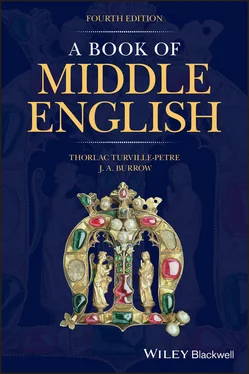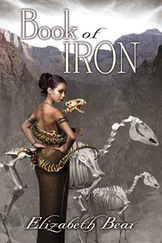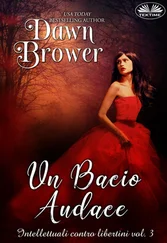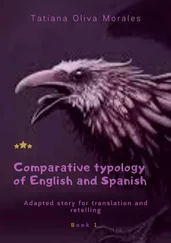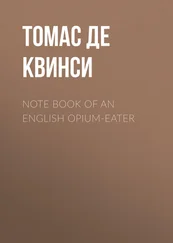1 ...8 9 10 12 13 14 ...27 The singular þis is generally undeclined, though some inflexional forms remain in Early Middle English: for example dative masculine þissen , 3/111, nominative feminine þos , 2/41.
4.3.8 The Indefinite Article
The indefinite article ‘a’ is an unstressed form of the Old English numeral ān , ‘one’. In early texts its spellings are very variable, as is illustrated within the one line An hule and one niʒtingale , ‘an owl and a nightingale’, 2/4. There are also some inflected forms, such as (in text 3) masculine accusative ænne , dative ane ; (in text 2) dative feminine ore . Even in these early texts the form is often reduced to a before a consonant: a word , 2/45.
4.4 Adjectives and Adverbs
4.4.1 Definite and Indefinite Inflexions
Adjectives of one syllable ending in a consonant, e.g. old , add ‐e in the plural, and also in the singular in certain circumstances: when used with the definite article þe , a demonstrative adjective þis or þat , a possessive pronoun such as hir or our , or a name or other term of address. In other circumstances the adjective has no ending. This survival of the Old English definite (or ‘weak’) declension contrasting with the indefinite (or ‘strong’) declension may be observed up to the end of our period in the metre of careful writers of the South, such as Gower and Chaucer. Some examples are:
|
singular |
plural |
|
indefinite (without |
definite (with þe , |
|
|
þe , demonstrative |
þis , þat , hire etc.) |
|
|
or possessive) |
|
|
| Text |
|
|
|
| 1: |
god man (72) |
þe ilce pining (76) |
gode men (73) |
| 4: |
lud dream (3) |
his wide þrote (68–9) |
sharpe word (30–1) |
| 5: |
a gret ost (290) |
þe selve way (341) |
wide wones (365) |
| 13: |
a chambre derk (205) |
þis proude vice (11) |
suche wiles (190) |
| 18a: |
a whit thyng (447) |
this white top (15) |
wilde mares (211) |
The signs are that the inflexion of adjectives was maintained in written English long after it was effectively dead in the spoken language. Though it had a metrical and rhythmic function, it could not survive the general silencing of final ‐e , and increasingly throughout the fourteenth century scribal disregard for final ‐e played havoc with the poets’ rhythms. So in Sir Orfeo , written down in about 1340, there are forms with unhistorical ‐e , such as it bled wete rhyming with fet (5/79–80), and forms that lack ‐e , such as þis ich quen (5/63), where the metre would be improved with an extra syllable.
Adjectives of more than one syllable are usually inflected in earlier texts, though less regularly in later ones: so manifældlice miracles , ‘numerous miracles’, 1/81, þe muchele angoise , ‘the great anguish’, 4/25, diverse kinges , 13/65, oþre þinges , 13/66.
Adjectives that etymologically end in ‐e in their uninflected form, such as fre , grene , swete (OE frēo , grēne , swēte ), remain unchanged throughout.
4.4.2 Inflexions for Case
Though this distinction between definite and indefinite adjectival inflexions survived for a considerable time, the Old English adjectival case system was dismantled much more rapidly. In Old English the adjective agreed with its noun in case, gender and number. Only in Southern and South‐Western texts do the case‐inflexions survive to a limited extent.
In Laʒamon’s Brut (text 3) there are, in addition to the ending ‐e (or ‐en ) for adjectives of the definite declension, the following inflexions for indefinite adjectives:
| singular |
|
|
| masc . |
nom . |
no ending: god (137) |
|
acc . |
‐ne: nenne (28), stærcne (59), bradne (115) |
|
gen . |
‐es |
|
dat . |
‐en: aðelen (11) |
| fem . |
dat . |
‐ere: ludere (30), hæhʒere (126) |
| plural |
gen . |
‐(e)re: alre (33), wihtere (125) |
In The Owl and the Nightingale (text 2), adjectives add ‐e for all cases in the definite declension, and all in the indefinite declension except the nominative singular of all genders and the accusative singular masculine and neuter. So when qualifying a noun that is subject the adjective has no ending, as the three here: þat plait was stif and starc and strong (l. 5); with a feminine noun that is object, the adjective has ‐e as in grete tale , ‘a great debate’ (l. 3).
4.4.3 Comparison of Adjectives
Comparatives and superlatives are formed, as today, by the addition of ‐er , previously ‐( e ) re , and ‐est to the positive form: wis , wiser , wisest ; laþ , ‘hateful’, laþre , laþest . Where the vowel is long, it is often shortened in the comparative and superlative, with the final consonant doubled, as greet , ‘great’, 18a/133; grettest , 18a/200. Cortays , ‘courteous’, has superlative curtest (11/249). Adjectives ending in ‐ly or ‐lich have, beside ‐lier and ‐liest , alternative endings ‐loker and ‐lokest : semloker , ‘more seemly’, 9/83; semlokest , 14g/6.
A few adjectives change their stem vowel: long , lenger ; old or ald , eldest ; strong , strengest .
Irregular forms are mostly familiar from Modern English; for example, in text 9: god , better , best ; littel , lasse , lest ; muche , more , most ; in text 1: yvel , werse .
4.4.4 Comparison of Adverbs
Adverbs have the same comparative and superlative forms as adjectives; e.g. sone , ‘quickly’, soner , sonest ; wisely , comparative wiselier , 15/38; swote , ‘sweetly’, superlative (dropping the final ‐t ) swotes , 14a/3. Longe , ‘for a long time’, has comparative leng or lenger : in the same text there is no leng abide , ‘stay no longer’, 5/84, and no lenger abide , 5/330. Neh , ‘nearly’, has comparative ner , and superlative next , although its comparative form is increasingly used simply to mean ‘nearly’: dispayred wel nere , 8/169. Wel has comparative bet and superlative best : ho wel wiste , ‘she knew well’, 2/147, on jousteþ wel, anoþer bet , 13/116.
4.5 Verbs
4.5.1 Introduction
In Middle English, as in Old and Modern English, the verb has just two tense‐forms, present and past. The way in which the past tense is formed divides the regular verbs into two classes, weak and strong. The great majority of verbs are weak and their numbers steadily increased, since most newly formed or introduced verbs were weak; also there was a tendency for verbs that were strong in Old English to become weak in Middle English. Many of the commonest verbs, however, are strong. The distinction between the two classes is that weak verbs form their past tense and past participle with ‘a dental suffix’, that is, an ending containing a d or t (e.g. in Modern English kill , laugh , learn , bend ), whereas strong verbs form their past tense and past participle by changing their stem vowel in accordance with an ancient rule that goes right back to the remote ancestor of English, the ‘Indo‐European mother‐tongue’. Examples of strong verbs in Modern English are drive , sing , bear , choose . However, a few verbs both have a dental suffix and change their stem vowel (e.g. in Modern English seek , buy , bring , think ); these are weak verbs, the change in their stem vowel not being ancient but having taken place in early Old English. See Guide to Old English , paragraphs 122–3.
Читать дальше
